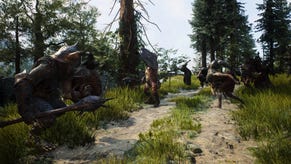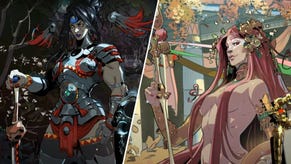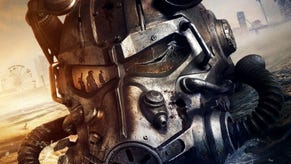Tomb Raider - from zero to hero? Not bloody likely
Tomb Raider is an origin story, showing us how Lara Croft became one of gaming's most recognisable action heroes. But that doesn't mean she starts off weak or spoiled, Brenna argues.
Lara Croft's story begins abruptly. There's a short cinematic, a montage of events showing the shipwreck of the research vessel Lara is traveling on, and then her attack on the beach by a mysterious assailant. Moments later, Lara awakens, tied upside down in a cave, and the player takes control.
It's not the most auspicious of beginnings. We're used to seeing Lara kicking arse and not even bothering to take names, so to see her so confused, frightened and helpless is jarring.
But although she's younger, and doesn't yet have the skills her later self will no doubt manifest, Lara is still Lara. Being locked up somewhere without any weapons was a regular occurrence in past Tomb Raider games, and this new version of Lara deals with the situation exactly as her past self would have: she figures out what needs to be done, and then does it - no matter what the odds, no matter what frightening things may be happening around her, and no matter what physical hardship she has to endure.
The difference is, she seems affected by it; a human being rather than a barely-animated heap of polygons. Soon after Tomb Raider's debut, critics began describing it as "torture porn" and calling out the fact that Lara is so disempowered, a situation very far removed from her gunslinging past. Lara's voice actor, Camilla Luddington, does an excellent job of communicating pain, effort and suffering, as Lara's grunts and cries of past games rarely did. It's uncomfortable to watch.
But it's nowhere near as uncomfortable as the torture porn it's been described as, because Lara doesn't sit around begging and pleading for help. Throughout the opening hours of the game she repeatedly does what Lara Croft has always done: shows enormous courage in getting the job done. She's not afraid of the dark or the monsters she knows well are in it. She doesn't need anyone to help her. She'll willingly put her wellbeing at risk if the goal is worth the gamble.
Lara doesn't react to her extreme situation as a normal human would. I know we all believe we're action heroes on the inside, but just you bark your shin on the coffee table and have to lie down and breathe deeply for a while; you'd be useless out there, disempowered. A disempowered character doesn't tear an object out of their own abdomen and get their feet; they lie down and cry, or die, or wait for help, just as most of us would. Lara, by contrast, gets up, and continues getting up. When the story calls for it, she learns the action skills we remember - shooting people and animals in the face, mainly, but also acrobatics - in addition to those she already possessed, which are formidable.
The events of Tomb Raider will shape Lara into the hero we remember, but it's her base personality, equipped with near superhuman amounts of physical and mental resilience and bravery, that allows the transformation to happen.
Later in the game we learn through flashback story sequences that Lara was already more than you average teenage girl. She doesn't get on that vessel a naive kid; she's a talented researcher whose opinion is respected by older and more experienced adventurers. She's been trained in survival and other vital expeditionary skills by her mentor, Roth.
The original Tomb Raider canon, patched and repatched as it was, is not so startlingly different. I now quote from the instruction manual of the 1996 original:
"Lara Croft, daughter of Lord Henshingly Croft, was raised to be an aristocrat from birth. After attending finishing school at the age of 21, Lara's marriage into wealth had seemed assured, but on the way home from a skiing trip her chartered plane had crashed deep in the heart of the Himalayas. The only survivor, Lara learned how to depend on her wits to stay alive in hostile conditions a world away from her sheltered upbringing."
It goes on, with Lara's return to civilisation and her discovery that she quite likes the rough life, actually. The implication is that prior to her accident, Lara was a spoiled rich kid, and she underwent a profound life change.
Of course, later games saw fit to fiddle about with this simple origin story. By Tomb Raider: Revelations, the fourth Core Design entry, Lara had been ret-conned to have been adventurous her whole life, and at age 16, acquired a mentor in Werner Von Croy. She was no longer the privileged socialite metamorphosed by tragedy, but instead, uh, a privileged socialite with some highly eccentric habits, like shooting people and animals in the face, acquired over a lifetime of training.
If you combine the two together, you get a picture very much like that Crystal Dynamics and Rhianna Pratchett have put together. A young, somewhat sheltered and privileged woman possessed of an extraordinary thirst for knowledge and the balls (if you'll forgive the inappropriately gendered term) to do anything is put in a situation requiring her to do everything. She does so, drawing on lessons gleaned from a lifetime of tutelage from various sources.
Core Design never showed us the plane crash in its first backstory, or how Lara grew from cheeky teenager to action hero in its second. In its earlier games, Crystal Dynamics didn't manage it either. In all past games we just had a vague description of an everyday although well-funded individual, a tragic event, and then bam! Full-blown sociopathy: the basic job requirement for all action heroes.
Tomb Raider is actually going to show us Lara's growth into a hero: tough as iron, fierce as fire, clever as a fox and with the gameplay-necessitated moral dimensionality of a snake. When the closing credits roll, I suspect she'll be the Lara Croft you remember, only significantly more consistent and three-dimensional. But what you need to remember is that for all her groans and breathy, hitching fear, when you first pick up that control pad - she's already the Lara you remember. You just don't know it yet.
Tomb Raider is due on PC, PlayStation 3 and Xbox 360 in early March.










